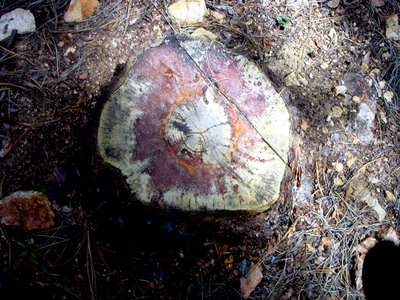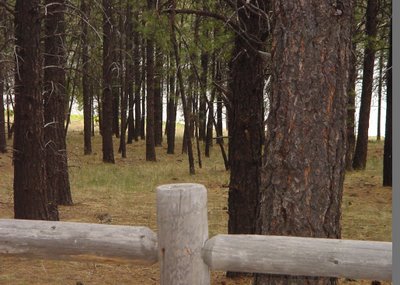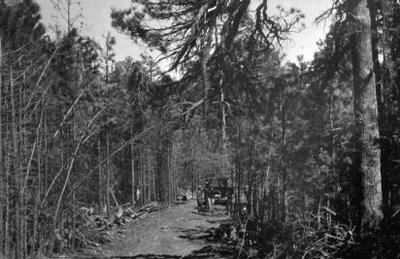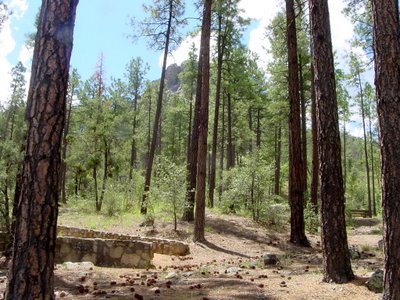
That, of course, is a ponderosa pine seedling. Fresh popped from the earth. If we have a few more rains like we had today, there will be many more of these would-be trees in the forest and in Prescott. (Up near Flag, my daughter plucks them out of the lawn like weeds!)

A handful are destined to take the place of these pines, dead from drought plus the bark beetle infestation that has decimated forests throughout the West.
Travelling through the forest locally, I've seen mountains, once thick with pines, which are now lucky to be covered with scrub. And there are those strange contrasts -- a barren hillside facing one direction while on the opposite side trees seem to be prospering -- or at least holding their own.

Those forests of dead snags are an open invitation to fires. Fortunately, many (by no means all) of the dead trees are finally being cut down. Some are even being harvested for a new lumber mill up near Ash Fork set up to turn beetle-killed wood into flake board or equivalent. Seems that the beetle lavae leave a blue stain that ruins the lumber cosmetically.
(One evening recently, I was having dinner with a group at a restaurant on west Gurley. We actually cheered when we saw a truck hauling timber down from the Thumb Butte area. This is the first logging our town has seen in quite a while.)

Look at those spindly ponderosas above! According to an NAU site on forest fires:
"Historical records from around the year 1900 show that the density of trees measuring 12 inches or greater in diameter at breast height (dbh) ranged from 8 to 51 trees per acre (Woolsey 1911). The forests were characterized as open and park-like, with diverse grasses, forbes, and shrubs in the understory. Numbers of trees in different age classes were evenly distributed with approximately equal numbers of young, middle-aged and old trees.
Today's forests are crowded with small-diameter ponderosa pines, leaving little room for the diversity of plant species that once flourished in the understory. Total tree densities now often exceed 1000 trees per acre (Allan 1998). The majority of the trees are young 50 to 100 year old trees with diameters of 3 to 6 inches dbh, fewer trees in the 6 to 9 inch class and even less in the 9 to 12 inch dbh class. Fire resistant trees, over 12 inches dbh, are relatively uncommon.
Credit our no-fire policy of many decades! Plus an unwillingness to thin the resultant jungle.

It looks like the dog hair thickets were already becoming common by the 1920s in Northern Arizona forests, if this photo from Forest Service archives is to be believed. Makes sense -- almost all the trees were logged off locally to fuel the mining, railroading and other economic activities of a growing community.
(Have you ever noticed while travelling north on SR89 near Ash Fork that the junipers all seem to be of a size? Those woodlands fed the firepots of the Santa Fe mainline for many years until coal replaced wood.)


We've been fortunate to have a periods with a little more rain the past couple of years and it appears that the current fall of pine cones has been good.

Look extra closely in the picture above and you'll see six pine seedlings. (Sorry, I had to do a lot of PhotoShopping to bring up what color was there!) Took the picture out by Thumb Butte; all of the seedlings I saw were in a blanket of pine needles, which helped hold the moisture in the ground.

Here are some three or four year old tree-lets. We won't be around to see them as big, prosperous old growth -- it takes far too long. Hope just one of them makes it -- no need to encourage "dog hair" thickets in the years ahead!



1 comment:
I remember these shots. Little babies. I have a strong emotional attachment to trees. I have, more than once, cried to see a grandfather or grandmother tree lose it's vital still life to the chainsaw because of in incoming road, development, on perceived need to "grow grass" in a yard. Grrrr.
Post a Comment